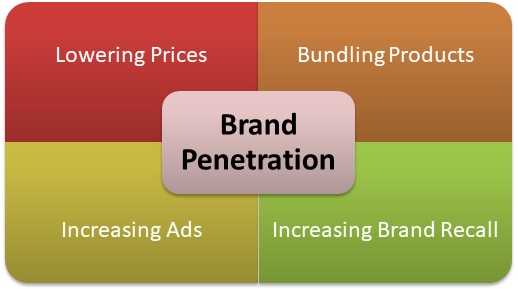- Business Concepts ›
- Marketing and Strategy ›
- Brand Penetration
Brand Penetration
Definition, Importance & Example
This article covers meaning & overview of Brand Penetration from marketing perspective.
What is meant by Brand Penetration?
Brand Penetration is a measure of the popularity of the brand. Brand penetration is defined as the number of people who buy a particular brand over a specific period of time divided by the size of the concerned market’s population. Brand penetration is a measure of adoption of a brand or the number of sales of a brand as compared to the total theoretical market for that brand.
Importance of Brand Penetration
Brand penetration is a business growth strategy in which several initiatives are being taken to increase the market share for its brand in a particular market segment. It is an effort to dig deeper into an existing market place. Thus, brand penetration is both measurement and projection of how successful a brand has been or will be against the competition & a critical component in brand management. Brand Penetration involves assertive sales force or additional marketing to penetrate deeply into an existing customer base.
Increased market share is most of the times, the objective for using “Brand Penetration” as a marketing strategy. It is generally the first step towards business growth and performed by early-age businesses.Importance of Brand Penetration
Brand Penetration Formula
Brand penetration is calculated as a percentage and is given by the following formula:
Brand Penetration (%) = Customers Who Have Purchased the Brand /Total Population
There are two important metrics which are: Penetration Rate & Penetration Share. Penetration rate is similar to Brand Penetration but Penetration Share is different. Penetration Share is determined by comparing that brand’s customer population to the number of customers for it’s category in the concerned market.
Brand Penetration Methods

Brand penetration techniques include lowering prices, advertisements, bundling products to gain traction, discounts, increasing the mailing list, enhancing brand recall etc. Brand Penetration is one of the four marketing strategies from the Ansoff Matrix for brand and market growth. The other three strategies are- market development, product development, and product/market diversification.
Advantages of Brand Penetration
1. “Brand Penetration” as a growth strategy is very effective in providing faster growth to the brand equity. When a brand offers reduced and better prices than the competitors, their customers tend to switch to this brand. Lower prices are linked to higher growth and the more reasonable the prices are, the higher is the impact.
2. Economies of Scale: With reduced prices and aggressive advertisement, products of that brand tend to sell more. With more sale, the brand compensates for the reduced prices of its products and even earn more profit than before.
3. Combat Competitors: Market Penetration urges loyal customers of other brands to experience this brand's products once. If the quality and price offered are the most reasonable, this strategy provides an opportunity for the brand to capture those loyal customers and become the market leader.
Disadvantages of Brand Penetration
1. Marketplace at some point of time becomes saturated which means that almost all of the existing customers or new customers have used, have been using or satisfied by the brand. At this point, investing heavily in marketing for this strategy may not do just for the investments made. Thus, the cost-benefit ratio has to be kept well in mind before implementing this strategy.
2. Aggressive marketing may help to convert a certain percentage of customers for the brand but the brand has to be ready for the competitor’s responsive attacks for capturing the market share.
3. Brand Penetration often leads to lowering of the industry prices. One brand lowers the price of its products to penetrate deeper in the market and soon other competitors do the same thing to stay in the competition which in turn lower the industry price for that product and brands end up making marginally low profits or even losses at times.
Brand Penetration vs Brand Development
Brand penetration focuses on increasing its customer base (those customers who have shown an interest in the product category but have not purchased this brand’s product or service) amongst the potential customer group. In brand Penetration, the market size is fixed. It focuses on capturing a greater share of the established customer base. On the other hand, brand development incorporates strategies to expand its potential customer group. It focuses on previously untapped market segment using its existing products and services or there may be potential customers in the non-buyer category who need to be introduced the alternated uses of products of that brand.
Example of Brand Penetration
For example, there is an auto insurance company in a city which has 40,000 licensed drivers. Out of this, the insurance company does not want to give its service to people who had tickets or accidents in the past which is 10,000 in number.
Thus, the remaining 30,000 becomes the target market size for this company.
Out of this 30,000, 3000 drivers have availed the insurance service from this insurance company.
Then, this insurance company’s penetration rate = (3000/30000)*100 = 10%
Hence, this concludes the definition of Brand Penetration along with its overview.
This article has been researched & authored by the Business Concepts Team which comprises of MBA students, management professionals, and industry experts. It has been reviewed & published by the MBA Skool Team. The content on MBA Skool has been created for educational & academic purpose only.
Browse the definition and meaning of more similar terms. The Management Dictionary covers over 1800 business concepts from 5 categories.
Continue Reading:
What is MBA Skool?About Us
MBA Skool is a Knowledge Resource for Management Students, Aspirants & Professionals.
Business Courses
Quizzes & Skills
Quizzes test your expertise in business and Skill tests evaluate your management traits
Related Content
All Business Sections
Write for Us